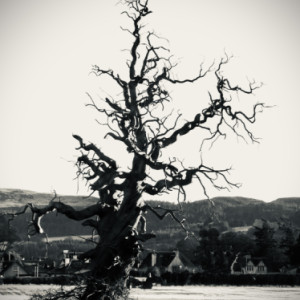Cromwell Tree
Another wonderful cold, bright and sunny day. Cycled to Bridge of Earn a few miles south of Perth. I used to live in the village and was always intrigued by this gnarled tree, but in the pre-internet days I had no way of finding out any more about it. Today I finally satisfied my curiosity and found the following information on the website of Kilgraston School, a girls' private school close to the village.
"Kilgraston is home to a sweet chestnut tree that, if sources are correct, is approaching 369 years of age. On 30th January 1649, King Charles I was executed on a scaffold erected in front of the Banqueting House of the Palace of Whitehall in Westminster, London. In response, on 5th February, the Parliament of Scotland declared his son, Charles II, who was living in exile in the Netherlands, to be King of Scots.
Charles returned to Scotland on 23rd June 1650, landing at Garmouth, Moray and signing the 1638 National Covenant and 1643 Solemn League and Covenant which brought both Scottish Royalists and Scots Covenanters rallying to his cause. Less than a month later, on 22nd July, Oliver Cromwell and his New Model Army arrived in Scotland from Ireland and, by the end of the year, they had taken control of the city of Edinburgh and much of southern Scotland.
In a largely symbolic gesture, Charles was crowned at Scone on 1st January 1651; by July, Cromwell’s army had crossed into Fife and begun to advance towards Perth, stopping to rest at Bridge of Earn where, it being a Sunday, it is said that Cromwell preached an eloquent sermon. The Royalist garrison at Perth surrendered on 3rd August and, to maintain control of the city and its surrounding countryside, Cromwell ordered a citadel to be built on land that is now occupied by South Inch car park.
Of greater significance here, though, is a Spanish chestnut (or sweet chestnut) tree that was planted on the Kilgraston estate on the day of Perth’s surrender. If the story of its planting is true, this tree would now be approaching 369 years of age. However, while the upper part of tree appears to be a mass of dead branches, the lower part does show signs of fresh growth. The tree is still visible across fields to the north of school, a still-living reminder of Britain’s turbulent political and religious history."


Comments
Sign in or get an account to comment.


